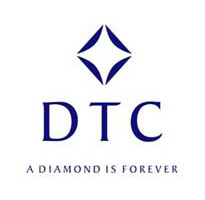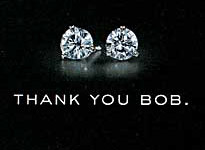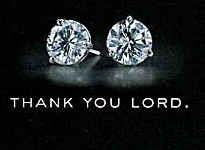Forever Diamonds
A powerful company, a catchy slogan, and how they forever changed the way we value diamonds.
By Barry B. Kaplan

The new DTC Logo
the "Forevermark"
Past, Present and Future
With the continued success of its existing marketing campaigns, De Beers sought new avenues to increase
diamond demand. In January 2000, J. Walter Thompson announced an extensive marketing campaign for the
"three-stone diamond anniversary ring", which featured a center half-carat stone flanked by two smaller-sized
side-stones. The three-stone ring initiative was targeted at couples celebrating their anniversary. Research
conducted by the advertising agency showed that female consumers shared a "desire to take stock of their
relationship in the present day, reflect upon the journey shared as a couple, and look forward to the many
happy years that lay ahead". The three-stone ring was tailor made for each facet of the relationship: Past,
present and future. The three-stone ring campaign was a tremendous success.
What's in a name?
Then, in September 2000, De Beers made sweeping changes to its identity. Instead of using its own name in
advertising, De Beers decided to use "Diamond Trading Co." (DTC). A new icon, called the ForeverMark shaped
like a diamond with a star in its center was unveiled to the public in January 2001. The decision to use DTC
instead of De Beers was an astute repositioning. De Beers would use the DTC name and the ForeverMark logo to
market their rough production and the "De Beers" name to sell an exclusive brand of diamonds in
soon-to-be-launched trendy De Beers stores.
In an effort to compete with the marketing budgets of other luxury goods, De Beers, realizing that diamonds
lagged other luxury goods in advertising expenditure, raised its 2002 advertising budget to almost $200
million. De Beers leveraged an additional $150 million of diamond advertising from its customers. These
enormous advertising resources helped launch the Fall 2002 ad campaign.


One of many two-paneled
DTC advertisements.
Bigger is better... again!
J. Walter Thompson's campaign was aimed at stimulating women's desire for larger diamonds. The ad agency's
research found that 82% of survey respondents desired jewelry with a diamond of at least a half-carat, but
few actually received such stones. The "Diamonds that Make a Statement" campaign was targeted at 25-54 year
old affluent married couples, earning a combined household income of at least $75,000. It featured products
such as stud earrings and solitaire necklaces.
The ads debuted in September 2002 featuring diamonds and advertising copy on an all-black background. Each
advertisement consisted of two panels. One panel showed a smaller diamond, the other showed the same design
with a larger diamond. Accompanying the photographs were humorous catchphrases like "Thank you, Bob ...
Thank you, Lord."
The De Beers branded diamond
In 2002 and 2003, four De Beers-branded diamond stores were opened - one in London, and three in Tokyo.
The store openings and diamond branding was part of a De Beers joint venture retail partnership with LVMH,
the world's leading luxury brands holding company that owns over 60 brands.
LVMH already owned several high-end fashion, leather goods, cosmetics, jewelry and watch brands, including
Louis Vuitton, Givenchy, Fendi, Christian Dior, and TAG Heuer. De Beers already controlled the majority of
the world's diamond rough production, but with new mines being discovered in Canada and the rest of the
world - many of which were not under the dominion of a De Beers alliance - it was only a matter of time
before De Beers' stranglehold on rough diamond supply was eroded. The goal of the De Beers LVMH partnership
was to help De Beers shift its core business away from mining and marketing of rough diamonds to the
development of a retail brand bearing the powerful De Beers name.



